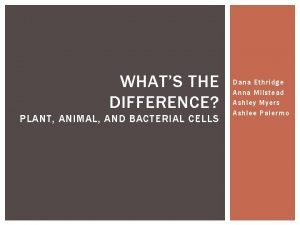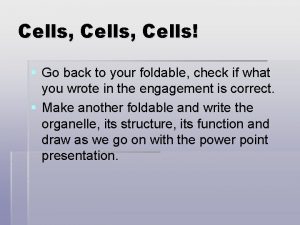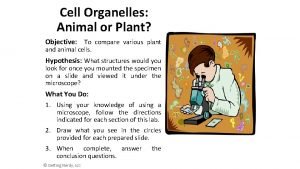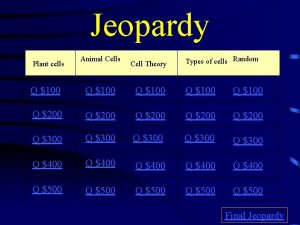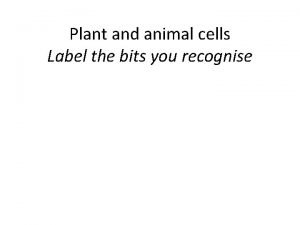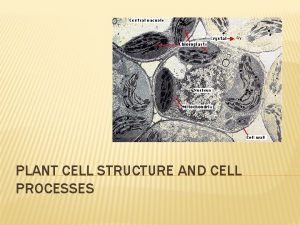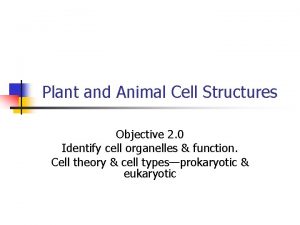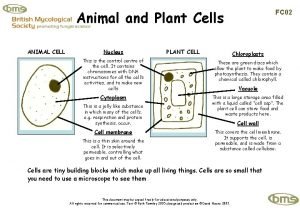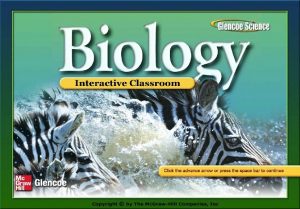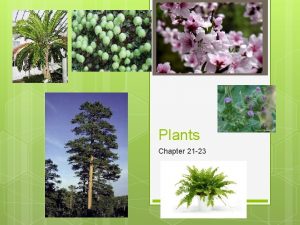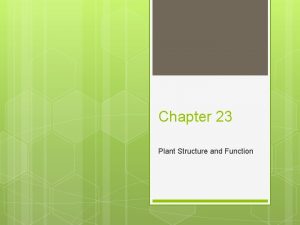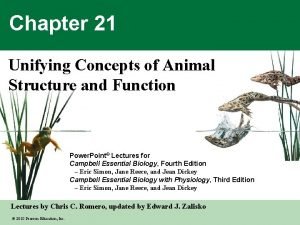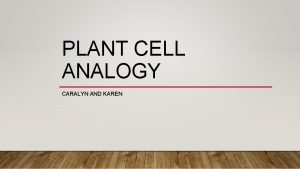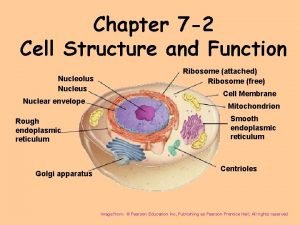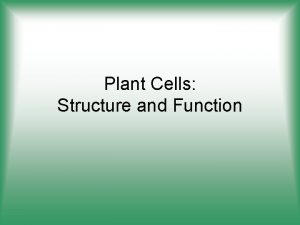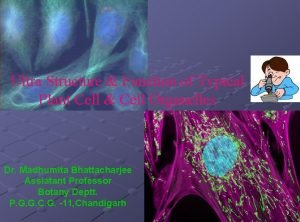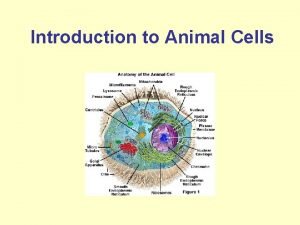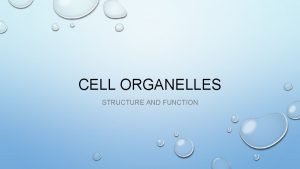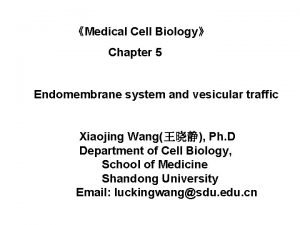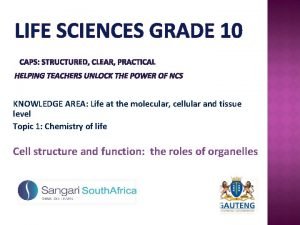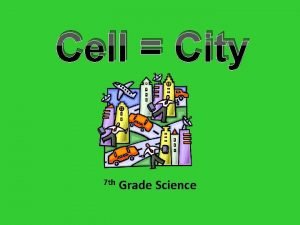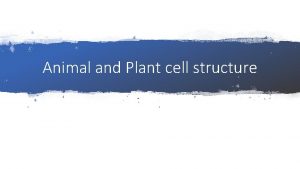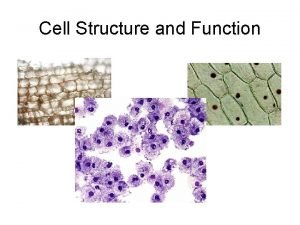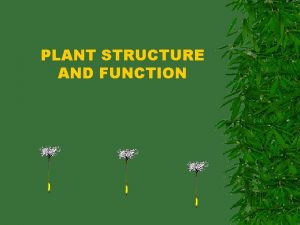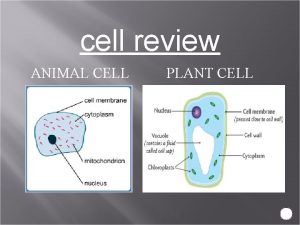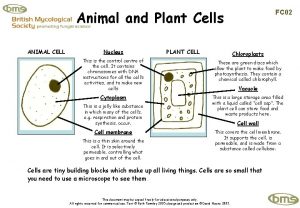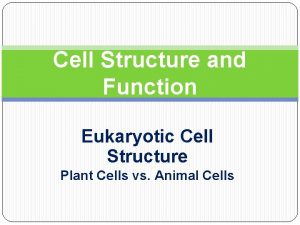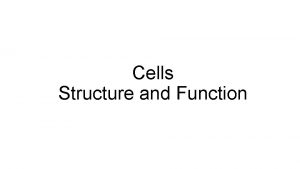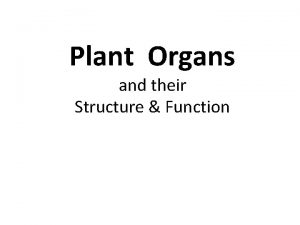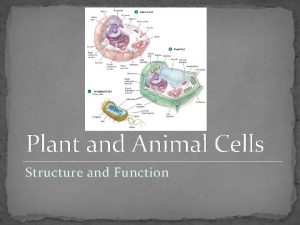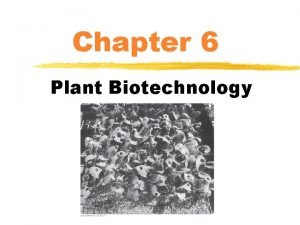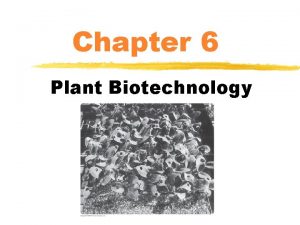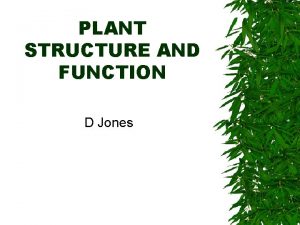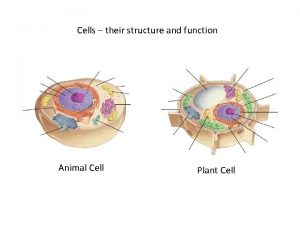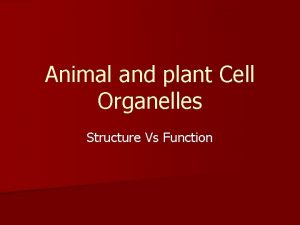Cell Structure and Function Animal Cell Plant Cell

































- Slides: 33

Cell Structure and Function

Animal Cell

Plant Cell

Plant Cells vs. Animal Cells Similarities Differences

Cell theory emerges A unifying concept in biology Originated from the work of biologists Schleiden and Schwann in 1838 -9 and the contributions of Rudoplh Virchow in 1850. • Every organism consists of one or more cells • The cell is the structural and functional unit of life • All cells come from pre-existing cells.

Our ability to study cells has improved dramatically Light microscope uses visible light to illuminate a specimen.

Our ability to study cells has improved dramatically Fluorescence microscope allows users to view light emitted from the specimen when it is illuminated with a specific wavelength of light.

Our ability to study cells has improved dramatically Electron microscopes use electrons instead of light. -Transmission electron microscope- electrons form an image after passing through the specimen -Scanning electron microscope- image forms from electrons that bounce off the surface of the specimen

The Nucleus The nucleus is the control center of the cell. It is the largest organelle in the cell and it contains the DNA of the cell. DNA forms structures called chromosomes. DNA (Deoxyribonucleic Acid) contains all the information for cells to live, perform their functions and reproduce. The Fluid inside the nucleus is known as the nucleoplasm The nucleolus is responsible for making r. RNA (ribosomal) that forms ribosomes. The circles on the surface of the nucleus are the nuclear pores. These are where ribosomes, and other materials move in and out of the Nucleus across the nuclear envelope

Anatomy of the Nucleus

The Cell Membrane • Also known as plasma membrane or phospholipid bilayer. • Selectively permeable: Allows certain things to enter the cell while keeping certain things out. • Made of a double layer of phospholipids with cholesterol, carbohydrate and protein molecules embedded.


The eukaryotic cell’s genetic instructions are housed in the nucleus and carried out by the ribosomes Ribosomes • Complexes of r. RNA and proteins • They are located on the ER or free in cytoplasm • Their function is protein synthesis

The endomembrane system regulates protein traffic and performs metabolic functions in the cell Endomembrane system Includes: • Nuclear envelope • ER • Golgi • Lysosomes • Vacuoles • Plasma membrane

Endoplasmic Reticulum Smooth ER • lacks ribosomes • Involved in synthesis of lipids, metabolism of carbohydrates, and detoxification of poisons Rough ER • Has attached ribosomes • Makes proteins and phospholipids Both have a double membrane Smooth ER Rough ER Nuclear envelop e ER lumen Smooth ER Rough ER 200 nm

The Golgi Body • Looks like a stack of pancakes • Transport vesicles-transport materials from the ER to the Golgi • Receives, modifies, manufactures, and stores products of the ER • Has a cis and trans side cis face (“receiving” side of Golgi apparatus) trans face (“shipping” side of Golgi apparatus)

Lysosomes • Lysosomes function as the cell's recycling compartment. • Sac filled with hydrolytic enzymes (produced by the Golgi) • Its function is to digest large molecules • After digestion, the remaining molecules are released into the cytoplasm for reuse. Nucleus 1 µm Vesicle containing two damaged organelles 1 µm Mitochondrion fragment Peroxisome fragment Lysosome Digestive enzymes Plasma membrane Lysosome Peroxisome Digestion Food vacuole Vesicle Mitochondrion Digestion

Vesicles This term literally means "small vessel". This organelle helps store and transport products produced by the cell. The vesicles are the transport and delivery vehicles like our mail and Federal Express trucks. Some vesicles deliver materials to parts of the cell and others transport materials outside the cell in a process called exocytosis

The endomembrane system regulates protein traffic and performs metabolic functions in the cell Nucleus Rough ER Smooth ER cis Golgi trans Golgi Plasma membrane

Mitochondria and chloroplasts change energy from one form to another Mitochondria • Found in all eukaryotic cells (about 1 -10 µm long) • Contains DNA • Double membrane-bound organelle • Can reproduce on their own • Sites of cellular respiration Intermembrane space Free ribosomes in the mitochondrial matrix Outer membrane Inner membrane Cristae Matrix

The Centrioles/Centrosome The centrosome, also called the "microtubule organizing center", is an area in the cell where microtubles are produced. Within an animal cell centrosome there is a pair of small organelles, the centrioles, each made up of a ring of nine groups of microtubules. There are three fused microtubules in each group. The two centrioles are arranged such that one is perpendicular to the other. During animal cell division, the centrosome divides and the centrioles replicate (make new copies). The result is two centrosomes, each with its own pair of centrioles. The two centrosomes move to opposite ends of the nucleus, and from each centrosome, microtubules grow into a "spindle" which is responsible for separating replicated chromosomes into the two daughter cells.


The cytoskeleton is a network of fibers that organizes structures and activities in the cell The functions of the cytoskeleton are diverse • Gives mechanical support to maintain cell shape • Providing anchoring for organelles • Can change the shape of a cell • Can move a cell from point A to point B • Can move cell parts

The cytoskeleton is a network of fibers that organizes structures and activities in the cell The components of the cytoskeleton are diverse • Microtubules • Shape and support the cell • Tracks along which cellular components move • Make up the structural components of cilia and flagella • Microfilaments • Withstand tension (pulling forces) • Network of microfilaments inside the plasma membrane keep cell shape (the cortex) • Important in muscle contraction • Intermediate filaments • Maintain cell shape (tension-bearing elements) • Anchor the nucleus and other organelles

Cilia -are thread-like projections of certain cells that beat in a coordinated fashion to create currents that sweep materials along - made of microtubules projecting from the cell membrane -If present, there are many cilia projecting from the cell membrane

Flagella - may extend to the rear of a cell and push it forward by snakelike wriggling, or stick out in front and draw it along. - We humans possess both flagella and cilia. Each sperm cell is propelled by a trailing flagellum that accelerates the little torpedo forward in its quest to fertilize an egg.

Plant Cell

Mitochondria and chloroplasts change energy from one form to another Chloroplasts • Found in plants • Contains DNA • Have a double membrane • Can reproduce on their own • Enable plants to convert solar energy to chemical energy (via photosynthesis) Ribosomes Stroma Inner and outer membranes Granum Thylakoid 1 µm

Plastids • Amyloplasts – Specialized organelles contained in plants only that store starch created through the process of photsynthesis. • Chromoplasts – Specialized organelles only contained in plants – Are many different colours ex// red, orange, yellow – Give plants their colour other than green such as flowers, fruits

Cell wall & Plasmodesmata In addition to cell membranes, plants have cell walls. Cell walls provide protection and support for plants. Unlike cell membranes materials cannot get through cell walls. This would be a problem for plant cells if not for special openings called plasmodesmata. These openings are used to communicate and transport materials between plant cells because the cell membranes are able touch and therefore exchange needed materials.

Vacuoles and vesicles are storage organelles in cells. Vacuoles are larger than vesicles. Either structure may store water, waste products, food, and other cellular materials. In plant cells, the vacuole may take up most of the cell's volume. The membrane surrounding the plant cell vacuole is called the tonoplast.

Turgor Pressure • Plant cells use their large central vacuoles for support. • The pressure created by the vacuole pushing against the cell wall, and the cell wall pushing back is known as turgor pressure. • This is a similar concept to the air in a tire.

Peroxisomes • Specialized metabolic compartments • Bounded by a single membrane • Peroxisomes produce hydrogen peroxide and convert it to water • Oxygen is used to break down different types of molecules (i. e. fatty acids) Chloroplast Peroxisome Mitochondrion
 Cytoplasm function
Cytoplasm function Plant cell animal cell venn diagram
Plant cell animal cell venn diagram Vacuole function
Vacuole function Idealized animal cell and plant cell
Idealized animal cell and plant cell Comparing plant and animal cells venn diagram
Comparing plant and animal cells venn diagram Flexible covering of an animal cell
Flexible covering of an animal cell Middle lamella
Middle lamella Whats the difference between animal and plant cells
Whats the difference between animal and plant cells Whats the difference between plant and animal cells
Whats the difference between plant and animal cells Plant cells
Plant cells Plant and animal cell under electron microscope
Plant and animal cell under electron microscope Plant and animal cell objectives
Plant and animal cell objectives Animal and plant cell jeopardy
Animal and plant cell jeopardy Label
Label Plant or animal cell
Plant or animal cell Which cell is larger plant or animal
Which cell is larger plant or animal Cell labeled
Cell labeled Animal or plant cell
Animal or plant cell Chapter 22 plant structure and function answer key
Chapter 22 plant structure and function answer key Chapter 21 plant structure and function
Chapter 21 plant structure and function Section 23-4 leaves
Section 23-4 leaves Unifying concepts of animal structure and function
Unifying concepts of animal structure and function Golgi apparatus analogy house
Golgi apparatus analogy house Endoplasmic reticulum function in animal cell
Endoplasmic reticulum function in animal cell Typical plant cell
Typical plant cell Which organelle
Which organelle Characteristics of animal cells
Characteristics of animal cells Centrosome function
Centrosome function Endomembrane system
Endomembrane system Animal cell structure grade 10
Animal cell structure grade 10 Spongebob cell analogy
Spongebob cell analogy Cell city introduction
Cell city introduction Carbohydrate side chain
Carbohydrate side chain Tronsmo plant pathology and plant diseases download
Tronsmo plant pathology and plant diseases download







